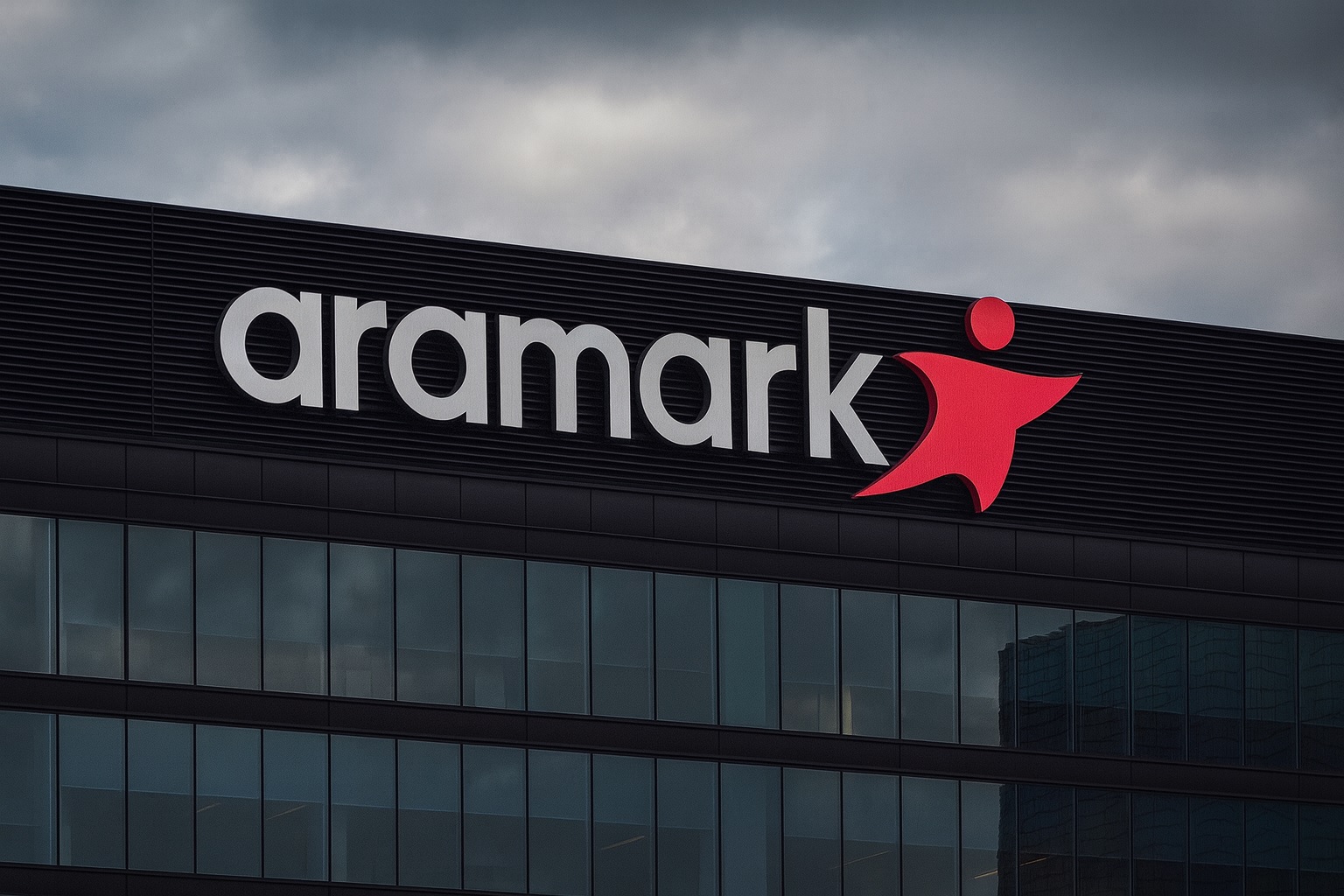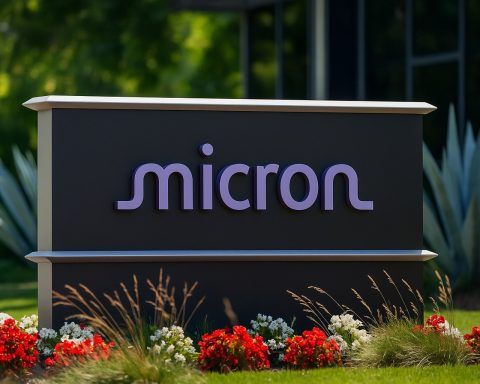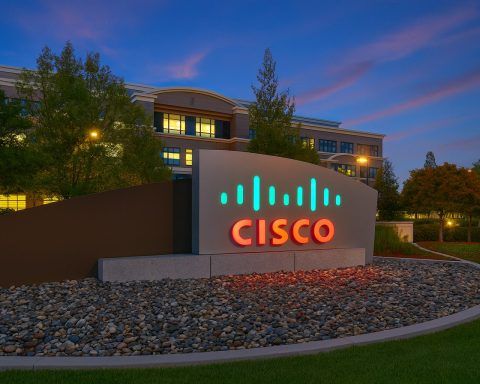Aramark (NYSE: ARMK) reported its fiscal fourth‑quarter and full‑year 2025 results before the U.S. market opened on Monday, November 17, 2025. The numbers showed strong full‑year growth, record new business wins and a higher dividend — but a softer‑than‑expected Q4 and “lofty” expectations sent the stock lower in today’s session. [1]
By late afternoon, Aramark shares were trading around $35.98, down roughly 5–6% from Friday’s close, on heavy volume. The drop follows a pre‑market slide that earlier reached nearly 8% after investors digested the earnings miss and guidance. [2]
At the same time, management laid out a fiscal 2026 outlook calling for 7–9% organic revenue growth and 20–25% adjusted EPS growth, signaling confidence that today’s weakness is more about expectations than a deterioration in the underlying business. [3]
All the Key Aramark Headlines from November 17, 2025
News flow around Aramark today has been dense. Major items published on November 17, 2025 include:
- Official earnings release: Aramark’s Business Wire announcement of Q4 and full‑year fiscal 2025 results, including detailed segment performance, cash flow, leverage and 2026 guidance. [4]
- Associated Press snapshot: A concise recap noting Q4 net income of $87.1 million, GAAP EPS of $0.33, adjusted EPS of $0.64 versus $0.65 expected, and revenue of $5.05 billion versus $5.16 billion forecast. [5]
- Zacks/Nasdaq analysis: Zacks calculates an earnings surprise of ‑1.54% and a revenue miss of ‑2.11%, and currently assigns Aramark a Zacks Rank #4 (Sell) despite the growth story. [6]
- Investing.com breakdown: Article highlighting that strong full‑year growth and margin expansion were overshadowed by the Q4 miss, with pre‑market shares down about 8% as investors reacted to the headline numbers. [7]
- Benzinga/inkl “Why Is Aramark Stock Sinking Monday?”: Focuses on the Q4 miss, the impact of incentive‑based compensation, and the company’s 2026 guidance, along with the announced dividend increase. [8]
- GuruFocus analysis: Emphasis on robust new business growth, a 12% jump in annualized gross new business wins to $1.6 billion, 96.3% retention, and net new business growth of 5.6% of prior‑year revenue, plus valuation metrics and target price. [9]
- Benzinga’s “Top Wall Street Forecasters Revamp Aramark Expectations Ahead of Q4”: Pre‑earnings piece summarizing Street expectations (EPS of $0.65 on $5.16 billion in revenue) and recent price‑target moves from UBS, Baird, Morgan Stanley and Citi. [10]
- Seeking Alpha commentary: One article notes that shares are “underwater” after solid results missed elevated estimates, while another upgrades Aramark to a “Buy” rating on the back of strong fundamentals and operational execution. [11]
Taken together, today’s coverage paints a picture of a company with solid momentum and healthier financials, but also one facing a valuation and expectations reset after a closely watched quarter.
Q4 2025: Growth Meets Expectations… But Not the Street’s
Aramark’s fiscal Q4 2025 (quarter ended early October) was, on the surface, a strong growth quarter: [12]
- Revenue: about $5.05 billion, up 14% year‑over‑year on both a GAAP and organic basis.
- Growth drivers: substantial new business wins, high retention, and solid base‑business volume, with an extra 53rd week adding roughly 7% to revenue.
- Operating income: roughly $218 million, essentially flat versus last year, while Adjusted Operating Income (AOI) rose 6% to about $289 million.
- GAAP EPS:$0.33, down 28% vs. the prior‑year quarter.
- Company‑defined adjusted EPS:$0.57, up about 6% year‑over‑year.
- Zacks‑style adjusted EPS: Zacks and AP, using a slightly different adjustment approach, cite adjusted EPS of $0.64 versus a $0.65 consensus, which they frame as a ‑1.54% EPS surprise. [13]
The shortfall versus expectations is what hit the stock:
- Analysts were looking for $5.16 billion in Q4 revenue and $0.65 in EPS. Aramark delivered $5.05 billion and $0.57–0.64, depending on the adjustment methodology, missing on both top and bottom lines. [14]
Why Did Margins Disappoint?
Management pointed to several factors that compressed earnings even as revenue grew: [15]
- About $25 million in additional incentive‑based compensation tied to record new business wins (roughly a 3% hit to Q4 AOI).
- Roughly $5 million in higher medical prescription claims, which management says they’ve now addressed.
- Start‑up costs associated with onboarding an “unprecedented” volume of new contracts, especially in Higher Education and Collegiate Sports.
- A non‑cash impairment on a minority equity investment, which weighed on GAAP EPS.
Excluding these items, the company estimates Q4 AOI margin would have been roughly 70 basis points higher, and AOI growth materially stronger, reinforcing the view that underlying operations remain healthy. [16]
Segment Performance
By segment, Q4 trends were broadly positive: [17]
- FSS United States
- Revenue: around $3.6 billion, up 14% year‑over‑year.
- Strength in Business & Industry (record net new business), Education (high retention, optimized meal plans, rising enrollment) and Healthcare (best performance in more than two years).
- Sports & Entertainment faced some drag from Major League Baseball clients missing the playoffs late in the quarter.
- FSS International
- Revenue: roughly $1.44 billion, up 16% year‑over‑year (about 14% organic).
- Broad‑based growth, particularly in the U.K., Canada, Ireland, Spain and Latin America, across Business & Industry, Healthcare, Education and Extractive Services.
In short: the business grew strongly, but Q4 profitability was squeezed by one‑time or near‑term items and by the cost of ramping a large wave of new accounts.
Full Fiscal 2025: Solid Growth, Better Margins and Lower Leverage
Stepping back from the noisy quarter, fiscal 2025 as a whole looks significantly better than fiscal 2024. [18]
Revenue and Profitability
For the full year:
- Revenue: about $18.5 billion, up 6% year‑over‑year; organic revenue grew 7% (currency shaved roughly $70 million).
- FSS United States revenue:$13.2 billion, up 5%.
- FSS International revenue:$5.3 billion, up 10% (11% organic).
- Operating income: climbed 12% to around $792 million.
- Adjusted Operating Income (AOI): also up roughly 12% to about $981 million, with modest margin expansion.
- GAAP EPS:$1.22, up from $0.99 in fiscal 2024.
- Adjusted EPS:$1.82, an increase of about 19–20% year‑over‑year.
Cash Flow, Debt and Capital Returns
Aramark also used fiscal 2025 to improve its balance sheet and reward shareholders: [19]
- Net cash from operations: up 27% to roughly $921 million.
- Free cash flow: up 41% to about $454 million.
- Leverage ratio: improved to 3.25x, the lowest level in nearly 20 years.
- Cash availability: more than $2.4 billion at year‑end, with about $639 million in cash and equivalents on the balance sheet.
- Share repurchases: more than 4 million shares bought back during the year, with additional buybacks underway via a 10b5‑1 program after year‑end.
- Dividend: the quarterly dividend was raised 14% to $0.12 per share, payable December 17, 2025, to shareholders of record as of December 5.
From a fundamental standpoint, fiscal 2025 marks a year of higher sales, higher profits, better cash generation and lower leverage, setting the stage for more flexibility in 2026.
Record New Business: 1.6 Billion Reasons the Pipeline Matters
A major theme in both the company release and third‑party coverage is Aramark’s record new business performance. [20]
Key commercial metrics for fiscal 2025:
- Annualized gross new business wins: about $1.6 billion, up more than 12% from 2024.
- Client retention:96.3%, with some business lines and countries even higher.
- Annualized net new business:5.6% of prior‑year revenue, well above the company’s long‑term target range of 4–5%.
- Flagship win: the largest contract ever awarded in the history of the U.S. Food & Support Services segment, involving a top‑tier medical system that begins operations early in the new fiscal year.
GuruFocus and others highlight these commercial wins as a key reason sentiment around the long‑term story remains constructive, even as short‑term earnings disappointed. [21]
Fiscal 2026 Outlook: Double‑Digit EPS Growth Target
Despite the Q4 wobble, Aramark’s fiscal 2026 guidance is ambitious: [22]
- Revenue:
- FY25 reference (52‑week basis): about $18.18 billion.
- FY26 guidance range: $19.55–$19.95 billion, implying ~7–9% constant‑currency organic revenue growth.
- Adjusted Operating Income:
- FY25 AOI: $981 million.
- FY26 AOI guidance: $1.10–$1.15 billion, or +12–17% growth.
- Adjusted EPS:
- FY25 adjusted EPS: $1.82.
- FY26 adjusted EPS guidance: $2.18–$2.28, or +20–25% growth.
- Leverage:
- FY25: 3.25x.
- FY26 target: below 3x.
Zacks consensus heading into the report called for FY26 EPS of about $2.25 on $19.58 billion in revenue, meaning the company’s guidance band essentially brackets Street expectations. [23]
In other words: guidance is not the problem. The pressure on the stock today is more about the Q4 miss and how much of the 2026 upside is already priced in.
How Wall Street and Quant Screens See Aramark Today
Reactions from analysts and quant services are mixed:
- Zacks currently rates Aramark a Rank #4 (Sell), pointing to an unfavorable trend in earnings estimate revisions despite the FY26 guidance. [24]
- Pre‑earnings analyst targets, summarized by Benzinga, skew positive: UBS (Buy, PT $45), Baird (Outperform, PT $47), Morgan Stanley (Equal‑Weight, PT $44), and Citi (Buy, PT $48). [25]
- GuruFocus notes: [26]
- P/E ratio: about 28x, above its historical median near 22.5x.
- P/S ratio: roughly 0.57.
- P/B ratio: about 3.24.
- Average target price: around $45.53 with a recommendation score near 1.8, which corresponds to a “Buy” leaning.
- Piotroski F‑Score: a robust 8, suggesting solid financial quality.
- Beta: about 1.2, implying higher volatility than the broader market.
- A Seeking Alpha contributor upgraded Aramark to “Buy”, arguing that while alternatives may offer more upside, the company’s operational progress and improving balance sheet justify a constructive stance on the shares. [27]
So, opinion is split: traditional quant rankings like Zacks are cautious, while many fundamental analysts and valuation‑focused services remain optimistic or outright bullish.
Key Themes for Investors to Watch
Whether you’re already in Aramark stock or just tracking ARMK on your watchlist, today’s news flow highlights several themes worth monitoring:
- New business ramp vs. near‑term margin drag
The company is onboarding a record amount of new business. That’s positive for long‑term revenue, but it brings start‑up costs and incentive compensation that can temporarily depress margins — exactly what showed up in Q4. [28] - Execution on 2026 guidance
Management has effectively promised double‑digit growth in AOI and EPS for fiscal 2026. Delivering on that plan will be crucial for rebuilding confidence after today’s sell‑off. [29] - Debt and capital allocation discipline
With leverage already at a 20‑year low and free cash flow rising, Aramark has room to keep investing, reducing debt, raising the dividend and buying back shares. The pace and balance of those choices will matter for total returns. [30] - Macro and sector risk
As a provider of food and facilities services to businesses, schools, hospitals and venues, Aramark is exposed to employment trends, consumer traffic, and public‑sector budgets. A slowdown in any of these could temper the growth trajectory. (This is a general sector risk, not specific to any single article.) - Valuation vs. growth
With the stock down today but still trading at a mid‑20s to high‑20s forward P/E range depending on your EPS assumption, investors will be weighing how much of the 2026 growth story is already embedded in the price. [31]
Bottom Line
For November 17, 2025, the Aramark story is essentially this:
- Operationally, fiscal 2025 was a strong year: higher sales, better margins, record new business wins, rising free cash flow and lower leverage.
- In Q4, the company ran into the buzzsaw of high expectations, with EPS and revenue coming in just shy of consensus, hurt by incentive compensation, medical costs and start‑up expenses.
- For 2026, management is still guiding to high‑single‑digit revenue growth and 20–25% EPS growth, suggesting the long‑term thesis remains intact if execution stays on track.
For investors, Aramark (ARMK) now looks like a “show‑me” story: the fundamentals and guidance are appealing, but the market is demanding proof that Q4’s shortfall was a blip rather than a trend.
Disclaimer: This article is for informational purposes only and does not constitute investment advice, stock recommendations, or a solicitation to buy or sell any security. Always do your own research or consult a licensed financial professional before making investment decisions.
References
1. www.businesswire.com, 2. ca.investing.com, 3. www.businesswire.com, 4. www.businesswire.com, 5. www.timesunion.com, 6. www.nasdaq.com, 7. ca.investing.com, 8. www.inkl.com, 9. www.gurufocus.com, 10. www.benzinga.com, 11. seekingalpha.com, 12. www.businesswire.com, 13. www.timesunion.com, 14. www.timesunion.com, 15. www.businesswire.com, 16. www.businesswire.com, 17. www.businesswire.com, 18. www.businesswire.com, 19. www.businesswire.com, 20. www.businesswire.com, 21. www.gurufocus.com, 22. www.businesswire.com, 23. www.nasdaq.com, 24. www.nasdaq.com, 25. www.benzinga.com, 26. www.gurufocus.com, 27. seekingalpha.com, 28. www.businesswire.com, 29. www.businesswire.com, 30. www.businesswire.com, 31. www.gurufocus.com







